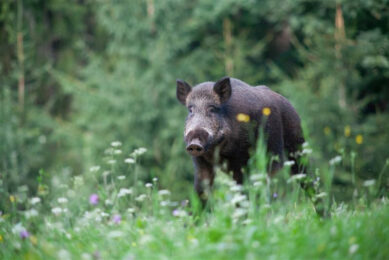Pig trials compare injectable and oral AI’s
Injectable, long-acting antibiotic therapy is a commercially viable alternative to antibiotics given in feed or in water. That’s the advice from one French veterinarian who took part in one of Europe’s largest ever commercial validation, or ‘reality’, trials.
Dr Marcel Dethinne from Union Cecab Prestor, France, was just one of more than 400 veterinarians from 11 countries who assessed the performance of Draxxin® (tulathromycin) in over 200,000 pigs. The results were unveiled recently in Paris.
“There is always some understandable hesitation, as well as curiosity, whenever we are presented with something new and different,†he said.
Actual performance
“Draxxin was the first injectable antibiotic to be approved for preventive use. It looked good on paper, but the real proof is always how these new ideas perform on real farms under everyday conditions.â€
The application for a preventive licence for Draxxin was supported by a number of scientific studies carried out in accordance with EMEA guidelines by Pfizer Animal Health. However, the company wanted to see how the product would perform in a range of commercial pig farms, in different European countries, under real life conditions, as Dimitri Popov, Product Manager for Swine Anti-infectives for Europe, Africa and the Middle East explained:
“Preventing swine respiratory disease using an injectable antibiotic was a new concept for European swine veterinarians and producers, so we wanted as many of them as possible to put Draxxin to the test on their own farms – hence the decision to conduct a series of reality trials.â€
Commercially viable alternative
“The aim was simply to see if they thought this was a commercially viable alternative to oral antibiotics in farms with different management systems, housing, and disease complex. We wanted veterinarians and farmers to see for themselves how well Draxxin will prevent SRD compared to the norm, which has been oral antibiotics.
At Pfizer, we knew it worked well in the lab and in scientific trials but we wanted to see how well Draxxin’s superiority holds up where it matters most … in the field. That’s why we were involved in over 1000 reality trials; the highest number Pfizer had ever conducted in the EU swine market.â€
The trials took place over a 10 month period and in 71% Draxxin was reported to be superior to oral anti-infectives. In 26% there was no difference between treatments and in 3% Orals were considered better.
“There is always some understandable hesitation, as well as curiosity, whenever we are presented with something new and different,†he said.
Actual performance
“Draxxin was the first injectable antibiotic to be approved for preventive use. It looked good on paper, but the real proof is always how these new ideas perform on real farms under everyday conditions.â€
The application for a preventive licence for Draxxin was supported by a number of scientific studies carried out in accordance with EMEA guidelines by Pfizer Animal Health. However, the company wanted to see how the product would perform in a range of commercial pig farms, in different European countries, under real life conditions, as Dimitri Popov, Product Manager for Swine Anti-infectives for Europe, Africa and the Middle East explained:
“Preventing swine respiratory disease using an injectable antibiotic was a new concept for European swine veterinarians and producers, so we wanted as many of them as possible to put Draxxin to the test on their own farms – hence the decision to conduct a series of reality trials.â€
Commercially viable alternative
“The aim was simply to see if they thought this was a commercially viable alternative to oral antibiotics in farms with different management systems, housing, and disease complex. We wanted veterinarians and farmers to see for themselves how well Draxxin will prevent SRD compared to the norm, which has been oral antibiotics.
At Pfizer, we knew it worked well in the lab and in scientific trials but we wanted to see how well Draxxin’s superiority holds up where it matters most … in the field. That’s why we were involved in over 1000 reality trials; the highest number Pfizer had ever conducted in the EU swine market.â€
The trials took place over a 10 month period and in 71% Draxxin was reported to be superior to oral anti-infectives. In 26% there was no difference between treatments and in 3% Orals were considered better.
When the veterinarians who took part in the trials were asked if they would use Draxxin in the future to prevent SRD, 85% said yes.
“The results from this study show that a long-acting antibiotic, given by injection is a way forward for many swine producers who currently use in-water or in-feed products to manage disease in their herd,†said Dr Dethinne.
“We can now recommend this different approach to our clients with confidence – knowing that it has been tried and tested in the real world.â€
Long duration
The long duration of action of Draxxin means that a single injection is sufficient to cure or prevent respiratory infection caused by susceptible pathogens. It also means less need for handling animals and much better compliance, said Dr Dethinne.
Technical Services Manager for Pfizer Animal Health in Belgium and Luxemburg, Willem Neirynck, was closely involved in a substantial number of the reality trial.
“This kind of trial is extremely valuable for veterinarians and their clients because it gives them the chance to see how new products perform under real commercial conditions.â€
“Understandably, many veterinarians are cautious regarding new ways in which products can be used, and are reluctant to use their clients as guinea pigs. So even products that make a big difference to swine production can be slow to catch on.â€
“I think the animal health industry should be conducting this type of investigation more often to check the commercial validity of their innovations in the real world.â€
Click here for the free Pig Progress newsletter
“The results from this study show that a long-acting antibiotic, given by injection is a way forward for many swine producers who currently use in-water or in-feed products to manage disease in their herd,†said Dr Dethinne.
“We can now recommend this different approach to our clients with confidence – knowing that it has been tried and tested in the real world.â€
Long duration
The long duration of action of Draxxin means that a single injection is sufficient to cure or prevent respiratory infection caused by susceptible pathogens. It also means less need for handling animals and much better compliance, said Dr Dethinne.
Technical Services Manager for Pfizer Animal Health in Belgium and Luxemburg, Willem Neirynck, was closely involved in a substantial number of the reality trial.
“This kind of trial is extremely valuable for veterinarians and their clients because it gives them the chance to see how new products perform under real commercial conditions.â€
“Understandably, many veterinarians are cautious regarding new ways in which products can be used, and are reluctant to use their clients as guinea pigs. So even products that make a big difference to swine production can be slow to catch on.â€
“I think the animal health industry should be conducting this type of investigation more often to check the commercial validity of their innovations in the real world.â€
Click here for the free Pig Progress newsletter











